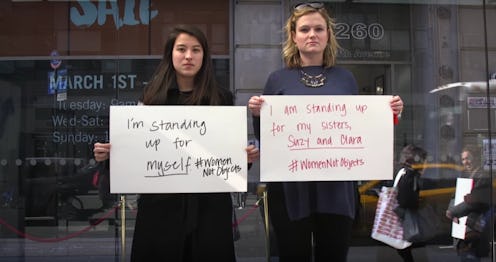
"The harm caused by the objectification of women in pop culture is not theoretical," reads the video "#IStandUp Against the Harm Caused By Objectification of Women in Advertising" by Women Not Objects. The video is part of a campaign to show what exactly objectification looks like — and how it harms women. Though there's a lot of debate about where the line is between depicting women as sexual beings and objectifying them, it's clear that there's a big difference between showing women in control of their own sexuality and depicting women in submissive positions or literally as objects, which is how the media often depicts us.
Women Not Objects's video shows not only media depictions in which women's bodies are used to advertise products but also the consequences of these images. Between plastic surgery and dangerous beauty procedures like Kylie Jenner's "lip challenge," women learn to objectify themselves by putting how they look before their physical comfort and emotional well being. As Capital University's Kacey D. Greening puts it, "women are conditioned to view their faces as masks and their bodies as objects."
The Stanford Encyclopedia of Philosophydefines objectification as "the treatment of a person as a tool for the objectifier's purposes," "the treatment of a person as lacking in autonomy and self-determination," and "the treatment of a person as lacking in agency." The consequences of this treatment include the normalization of sexual assault on college campuses and throughout our society and the pressure for women to conform to unrealistic beauty standards.
To remind the world that they are people, not objects, women are using the hashtag #IStandUp. Learn more about objectification and its most dire consequences in the video below:
Images: WomenNotObjects/Youtube